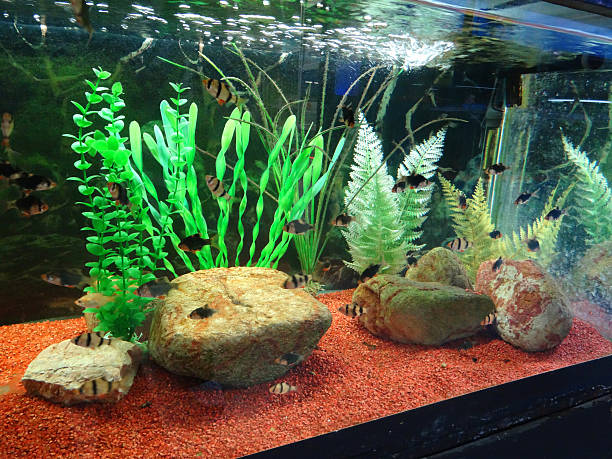Embark on the enlightening journey of aquarium care by delving into the art of Aquarium Lighting. Choosing the right lights for your tank is a pivotal aspect, influencing not only the visual appeal but also the well-being of your aquatic inhabitants.
Lighting serves beyond aesthetics, playing a crucial role in simulating natural conditions for plants and fish. The right spectrum and intensity promote plant growth and enhance the vibrancy of fish colors.
Consider your aquarium’s inhabitants and purpose when selecting lights. Different species have varied lighting needs, and the right choice fosters a thriving and balanced aquatic environment.
LED lights have become a popular choice for their energy efficiency and customizable features. They offer a spectrum suitable for plant growth and create a visually appealing atmosphere for your aquarium.
Balancing the duration of light exposure is essential. Mimic a natural day-night cycle with a consistent lighting schedule, preventing stress and promoting natural behaviors in your aquatic companions.

In this exploration of Aquarium Lighting, understanding the diverse needs of your tank inhabitants guides the selection process. The right lights not only illuminate but also contribute to the health and vitality of your underwater ecosystem.
Understanding Light Needs
Embark on the illuminating journey of aquarium care by delving into the crucial aspect of understanding light needs. This exploration is fundamental for creating a balanced and thriving environment for your aquatic companions.
Different species of fish and plants have varied requirements when it comes to light. Some may thrive in bright, well-lit conditions, while others prefer subdued or indirect lighting. Understanding these preferences is key to their overall well-being.
Consider the natural habitat of your aquarium inhabitants. Species originating from environments with ample sunlight may require brighter lights, replicating their native conditions. Conversely, species from shaded or darker habitats might benefit from softer lighting.
Plants play a vital role in aquarium ecosystems, and their light needs are crucial for growth. Different plant species have varying requirements regarding light intensity and spectrum. Matching these needs ensures a flourishing aquatic garden.
Balancing the lighting needs of fish and plants is essential. Too much light can lead to stress, algae overgrowth, and adverse effects on water parameters. On the other hand, insufficient light may hinder plant growth and impact the overall vibrancy of the aquarium.
Consider the purpose of your aquarium—whether it’s a planted tank, a community of fish, or a specialized environment. Tailoring the lighting to meet the specific needs of your aquarium’s inhabitants ensures a harmonious and visually appealing underwater world.
In conclusion, understanding the light needs of your aquarium is akin to providing the right conditions for a thriving ecosystem. It involves a thoughtful consideration of the diverse requirements of fish and plants, creating an environment that promotes their health, vitality, and the overall aesthetic appeal of your underwater haven.
Spectrum and Intensity Considerations
Delve into the nuanced realm of aquarium lighting, where spectrum and intensity considerations play a pivotal role in fostering a vibrant and healthy underwater environment. Understanding and optimizing these factors are key to creating an ideal habitat for your aquatic companions.
The spectrum of light refers to its color range, and different wavelengths have distinct effects on plants and fish. For lush plant growth, favor light in the blue and red spectrum, while a full spectrum benefits the overall aesthetics of the aquarium.
Consider the intensity of light emitted by your aquarium fixtures. The intensity should align with the specific needs of your inhabitants, balancing the requirements of both fish and plants. High-intensity lighting may be suitable for a planted tank, while lower intensity is preferable for certain fish species.
Plants rely on specific light wavelengths for photosynthesis, and providing the right spectrum is crucial for their well-being. Blue light stimulates vegetative growth, while red light encourages flowering and fruiting. Finding the balance enhances both visual appeal and plant health.
Understanding the natural behaviors of your fish aids in determining the appropriate light spectrum. Some species, particularly those from dimly lit habitats, may thrive with subdued lighting, reducing stress and promoting natural behaviors.
Intensity considerations extend beyond the type of lighting to the duration of exposure. Mimic a natural day-night cycle by establishing a consistent lighting schedule. This ensures your aquarium inhabitants experience periods of light and darkness, contributing to their overall well-being.
In conclusion, spectrum and intensity considerations in aquarium lighting are not merely technicalities; they are the artistic brushstrokes that paint a dynamic and visually stunning underwater canvas. By tailoring these factors to the unique needs of your fish and plants, you create an environment that not only thrives aesthetically but also fosters the health and vitality of your aquatic community.
LED Lights: Efficiency and Customization
Embark on an enlightened path in aquarium lighting with the efficiency and customization offered by LED lights. These lighting marvels have revolutionized the aquarium hobby, providing benefits that extend beyond mere illumination.
Efficiency is a hallmark of LED lights, as they consume less energy compared to traditional lighting options. This not only reduces electricity costs but also contributes to a more environmentally friendly and sustainable aquarium setup.
LED lights emit low heat, preventing temperature spikes in the aquarium. This characteristic ensures a stable environment, reducing the risk of stress or harm to your aquatic inhabitants.
The lifespan of LED lights is significantly longer than other lighting options. With durability and reliability, they offer a cost-effective solution in the long run, requiring less frequent replacements and maintenance.
Customization options with LED lights provide aquarists with unparalleled control over the visual aesthetics of their aquarium. Adjusting color spectrums and intensities allows for the recreation of natural lighting conditions and enhances the overall beauty of the aquatic habitat.
Programmable features enable the simulation of sunrise and sunset effects, creating a gradual transition between light and darkness. This not only mimics natural conditions but also promotes the well-being of fish by reducing abrupt changes in lighting.
LED lights are available in various designs, making them suitable for different tank sizes and layouts. Their versatility allows for creative placement, ensuring optimal coverage and intensity tailored to the specific needs of your aquarium.
In conclusion, LED lights shine as beacons of efficiency and customization in the world of aquarium lighting. Their energy efficiency, longevity, low heat emission, and customizable features make them a preferred choice for aquarists seeking a dynamic and visually stunning underwater showcase.
Balancing Light Exposure
Navigate the delicate dance of aquarium lighting by understanding the significance of balancing light exposure. This crucial aspect ensures a harmonious environment, promoting the health and natural behaviors of your aquatic inhabitants.
Establishing a consistent lighting schedule mimics the natural day-night cycle, reducing stress for your fish. Providing a stable routine helps create a familiar and comfortable environment, fostering a sense of security.
Consider the lighting needs of your aquarium’s inhabitants when determining the duration of light exposure. Some fish and plants may thrive with longer periods of light, while others require shorter intervals.
Avoid prolonged exposure to light, as it can lead to stress, algae overgrowth, and adverse effects on water parameters. Balanced lighting prevents these issues, creating a visually appealing and healthy aquarium.
Utilize programmable features available in many lighting systems to simulate sunrise and sunset effects. This gradual transition between light and darkness replicates natural conditions, promoting the well-being of your fish.
Monitor the overall brightness in the aquarium, ensuring it aligns with the specific needs of your inhabitants. Some species may prefer subdued lighting, while others thrive in brighter conditions. Finding the right balance contributes to the overall vitality of the aquarium.
Consider the placement of lights to achieve uniform coverage. Ensure that all areas of the aquarium receive adequate light, preventing shadows and promoting the healthy growth of plants.
In conclusion, balancing light exposure is an art in aquarium care. By tailoring the duration, intensity, and schedule of light, you create an environment where your fish and plants flourish, showcasing the vibrant beauty of a well-balanced underwater world.
Inhabitants’ Diverse Lighting Needs
Embark on a journey into the diverse world of aquarium inhabitants, each with unique lighting needs. Understanding and catering to these specific requirements are crucial for creating a thriving and visually appealing underwater environment.
Fish species exhibit varied responses to lighting based on their natural habitats. Some, originating from shaded areas, may prefer subdued lighting to feel secure and exhibit natural behaviors. Others, from brightly lit environments, thrive in well-lit conditions.
Consider the activity levels of your fish when determining lighting needs. Nocturnal species may prefer lower light during the day to mimic their natural sleeping conditions, while diurnal fish often benefit from brighter lighting to simulate daylight.
Plant species in your aquarium contribute to its aesthetics and overall health. Different plants have distinct lighting requirements, particularly regarding intensity and spectrum. Tailoring the lighting to match these needs promotes lush plant growth and a balanced ecosystem.

Selecting the appropriate lighting for a community tank with diverse inhabitants can be challenging. Finding a middle ground that meets the preferences of various species ensures a harmonious environment and prevents stress.
Inhabitants with vibrant colors, such as certain tropical fish, may showcase their full beauty under specific lighting conditions. Adjusting the spectrum and intensity to enhance the colors of your fish adds to the visual appeal of the aquarium.
Observing the behavior and health of your inhabitants provides valuable insights into their lighting preferences. If fish appear stressed or plants show signs of poor growth, adjustments to the lighting setup may be necessary to accommodate their diverse needs.
In conclusion, recognizing and addressing the diverse lighting needs of your aquarium inhabitants is a key element in achieving a balanced and thriving underwater world. By tailoring the lighting to the specific requirements of different species, you create an environment where each inhabitant can flourish, contributing to the overall vitality and beauty of your aquatic ecosystem.
Conclusion
In the radiant world of aquariums, selecting the right lights is the beacon of success. Understanding the unique needs of your aquatic inhabitants guides you in creating an environment where they not only survive but thrive.
Consider the spectrum and intensity of light to match the preferences of your fish and plants. This thoughtful selection contributes to the visual appeal of your aquarium and promotes the overall well-being of its inhabitants.
LED lights stand out as efficient and customizable solutions, offering not just illumination but an artistic touch to your aquatic showcase. Their energy efficiency, longevity, and programmable features make them a top choice for aquarists seeking a dynamic and visually stunning underwater haven.
Balancing light exposure is an art that mimics the natural day-night cycle, reducing stress for your fish. Consistency in the lighting schedule provides a stable environment, fostering a sense of security for your aquatic companions.
Recognizing the diverse lighting needs of your inhabitants is paramount. From nocturnal to diurnal species, and lush plants to colorful fish, tailoring the lighting to meet their preferences ensures a harmonious and thriving underwater world.
In conclusion, the right choice of aquarium lighting transcends mere brightness; it’s a key to unlocking the vibrancy and health of your aquatic environment. By understanding the nuanced lighting needs of your tank’s inhabitants and leveraging modern lighting solutions, you craft an underwater masterpiece that captivates the eye while providing a sanctuary for your fish and plants.





